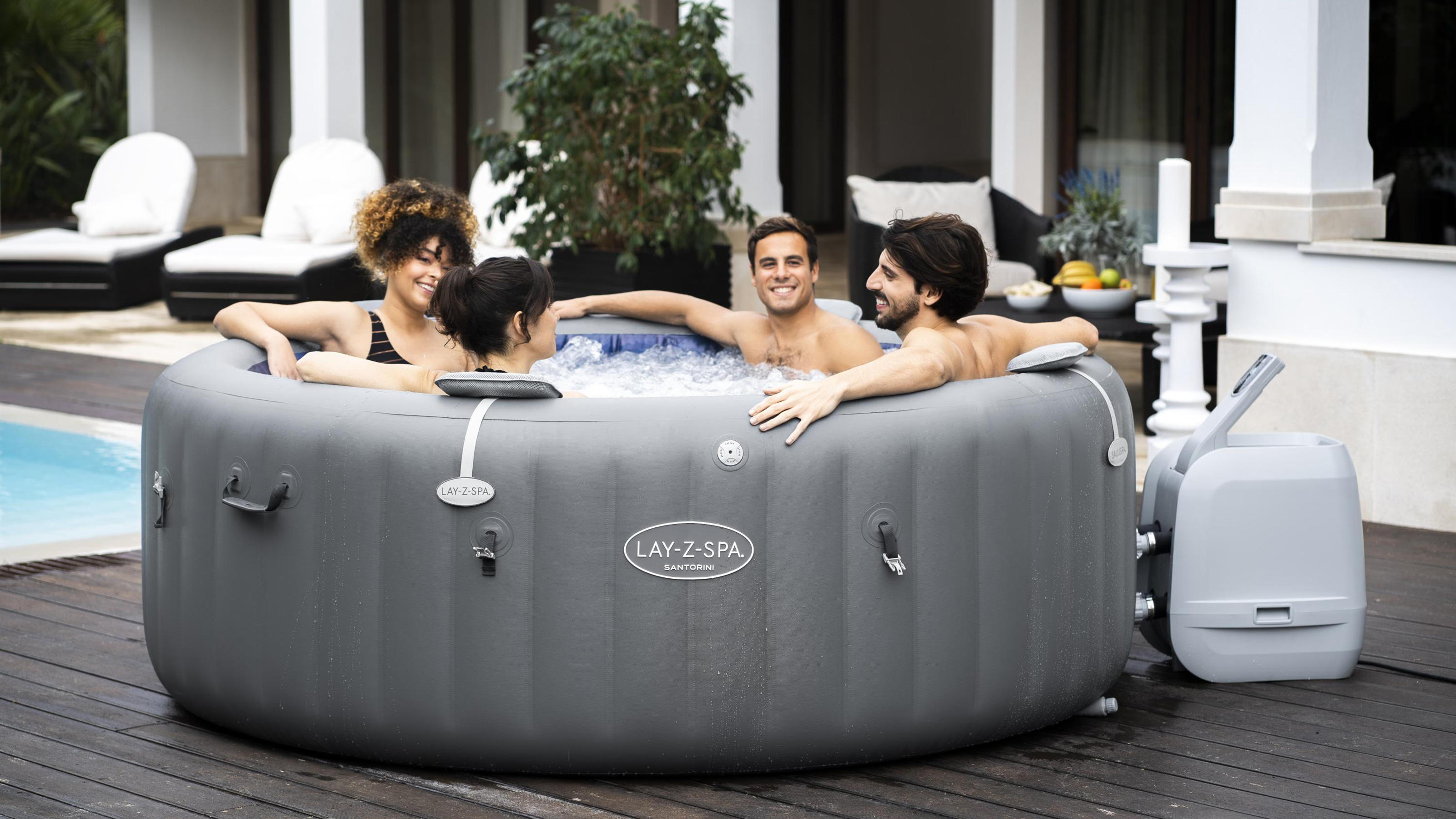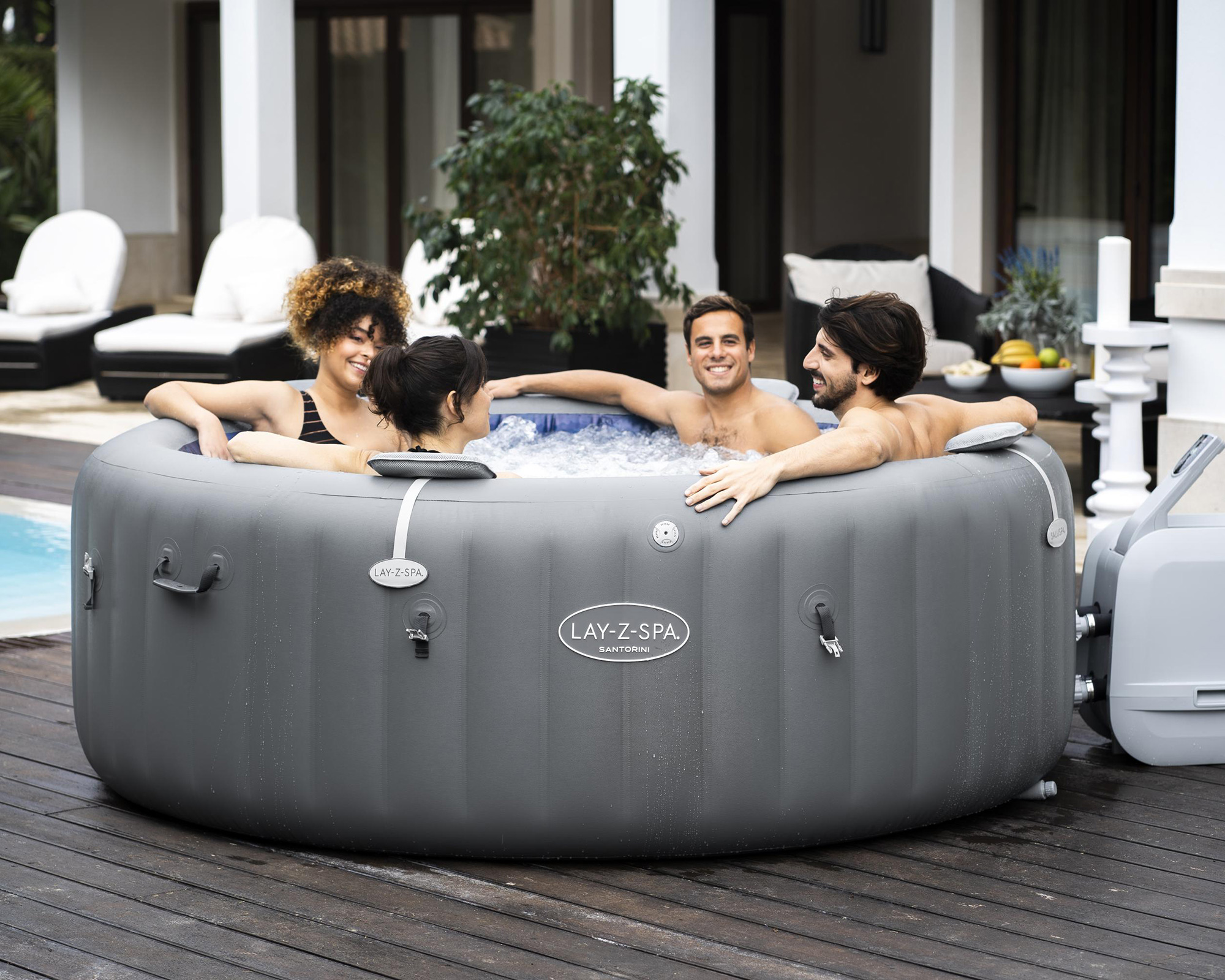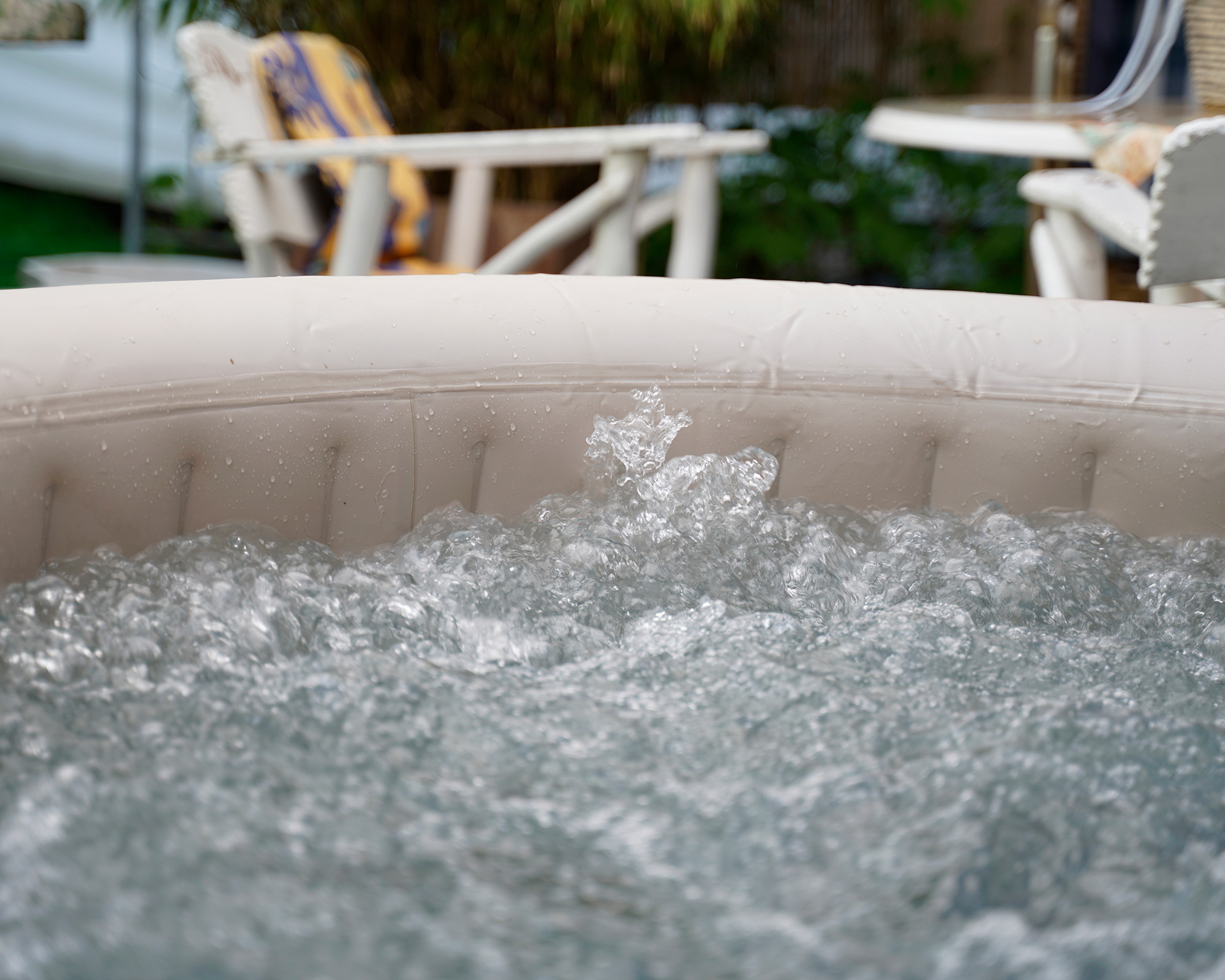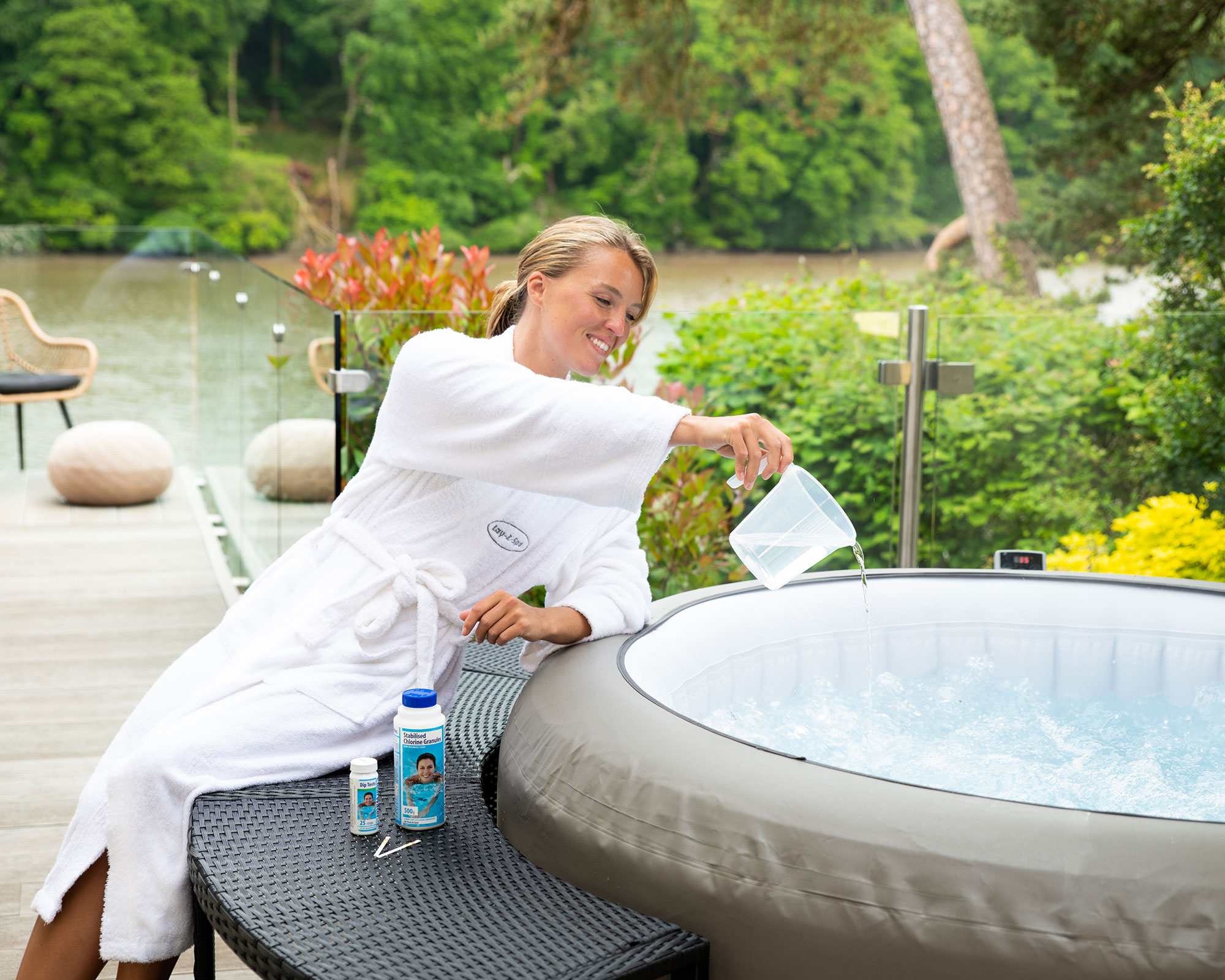Are inflatable hot tubs any good? The pros and cons explained
Are inflatable hot tubs any good and is one of these the right choice for your yard? This is what you need to know


If you’re attracted by the ease with which you could add one to your backyard, you might also be wondering, are inflatable hot tubs any good?
The merits of an inflatable hot tub that might have caught your attention include that it can be a relatively low cost option, and that it’s straightforward to install in the yard. Plus, unlike a hard shell hot tub, you can take it with you on a camping trip, or when you move home.
To allow you to ascertain whether number one among your hot tub ideas should be an inflatable, we’ve put together an expert guide on their benefits, and the possible disadvantages.
Are inflatable hot tubs any good? Your questions answered
The best hot tubs on offer include hard shell and traditional wooden designs as well as inflatable versions. But are inflatable hot tubs any good? It’s worth noting that because of developments in technology they could prove to be a far different proposition than you expect. This is what you need to know before spending.

The benefits of an inflatable hot tub
If you’re weighing up the question are inflatable hot tubs any good, consider these points in favor.
- Inflatable hot tubs are a lower cost choice: ‘An inflatable spa makes a great entry-level product; they are reasonably low priced and give people the chance to try out the benefits of relaxing in a home spa without committing to a more permanent hot tub,’ says Sallie Leslie-Golding from BISHTA (The British and Irish Spa and Hot Tub Association). There tends to be plenty of hot tub deals available on inflatable models throughout the year too.
- Installation is easy: Inflatable hot tubs are very simple to set up, plug and play style. You can use a standard outlet rather than needing to have the hot tub hardwired in by an electrician – which, of course, entails additional expenditure. An inflatable hot tub needs level ground that can support the weight of the filled tub and the maximum number of occupants, and should be positioned out of the wind, but installation isn’t more complicated than that. And getting the hot tub into the yard in the first place is straightforward, too.
‘Traditional spas have strict requirements about where they can be placed, and this usually involves installing a concrete pad,’ says Jen Rhodes, founder and editor of Tubtopia. ‘You also need clear access to get the spa into place, which sometimes means removing fence panels.’ - Placement is flexible: Providing you follow the guidelines on locating a hot tub, you don’t need to stick to one location in the yard. ‘Since they can be deflated, they’re very easy to move around the yard whenever necessary, or if you change your mind about where you want the spa,’ says Jen.
- They’re easily stored and portable: An inflatable hot tub could bring luxury to your outside space at an affordable price, but it’s also handy because you can store it when it’s not required. Even better, you can enjoy its benefits when you’re on vacation.
‘They are far more convenient in the sense that you can pack them away when they are not being used and you can take them with you when you move home,’ says Tom Drakett-Cain, brand marketing manager at Lay-Z-Spa. ‘You could even take them camping if you wanted to.’
Will Stewart, co-founder of Cedar Spring Recreation agrees on their versatility. ‘Think: bring your own hot tub to an Airbnb weekend rental and put it in the backyard,’ he says.
‘For people who are always on the move with their RVs or love camping outdoors, the portability and easy installation functions of inflatable hot tubs are a great addition to have,’ agrees Georgia McBroom, co-founder of CamperFAQs. ‘Having some relaxation after a long day of setting up camp, hiking, or whatever outdoor activities you have is what to love in these portable tubs.’ - Inflatable hot tubs come in a range of sizes: Inflatable definitely doesn’t equal small. Although you can opt for a more compact version with space for two to four people, you’ll find six person inflatable hot tubs widely available and even some bigger models, fitting up to seven or eight.
- They can be a cohesive part of a garden design: An inflatable hot tub can be an appealing feature. ‘They can add aesthetic and functional value to your garden or backyard,’ says Tory Jon of Pond Academy, who has worked with clients who want to incorporate inflatable hot tubs into their backyard design. ‘Some of these inflatable hot tubs come with stylish designs, patterns, and colors, so you can mix and match them with your whole garden or backyard look.’ Combining them with the latest hot tub surround ideas is a key way to incorporate them into your yard.

The potential drawbacks of an inflatable hot tub
An inflatable hot tub can be a great addition to a yard, but you might be wondering about its downsides when compared to a permanent, hard-shell hot tub.
- Costs to heat: An inflatable hot tub could bring higher in-use costs. ‘Surprisingly, inflatable hot tubs can cost more to heat and run than traditional hot tubs which should be a factor for anyone who is looking for one to be a permanent backyard amenity,’ says Will Stewart.
Always find out about running costs when making a purchase. ‘Some hot tubs are more energy efficient than others,’ explains Sallie Leslie-Golding. ‘Hot tubs advertised cheaply can be poorly insulated, so always ask your retailer how cost-effective they are to run and can they provide any published figures to ensure that the hot tub has good insulation properties.
‘Several factors will affect the running costs of hot tubs, including heat losses, the amount and type of insulation (or lack thereof), and usage. Firstly, the water volume that needs heating will have a bearing. The greater the volume that needs heating, the higher the running costs. Some hot hubs may hold around 1,000 litres.
‘Water temperature is typically set between 96.8°F and 104°F (36°C to 40°C), but in the summer, especially during very hot weather, this might be reduced to make the temperature more comfortable. The higher the water temperature is set, the more energy will be required to maintain it and therefore, the higher the running costs.’
And while we’re talking heating, bear in mind that most inflatable hot tubs take a long time to heat up. ‘If you’re taking it to an Airbnb it won’t be hot for probably a day or longer,’ says Will. Check heat-up time before committing to a model. - Inflatable hot tubs don’t all have seating and other luxury features: When it comes to entertaining or just chilling out, some inflatable hot tubs can’t compete with their permanent counterparts. ‘If relaxation is the primary reason for purchase, note that inflatable hot tubs generally lack comfortable or structured seating,’ says Will. The jets can be less sophisticated, too. ‘Inflatable spas do not have the kind of powerful hydrotherapy jets you find in high-end acrylic spas. Instead, they blow air into the spa to create a bubbling effect,’ explains Jen. However, there are exceptions, and it is possible to find these features in some inflatable hot tubs. ‘Our top-end models include seating, and AirJet and HydroJet massage system, and LED lights,’ says Lay-Z-Spa's Tom Drakett-Cain.
- Cold weather could stop use: ‘Most inflatable spas are only designed to be used for around six or seven months of the year, or when average temperatures are above 40°F (5ºC),’ says Jen. ‘If you live somewhere with very cold winters, this means you will need to drain the spa and store it over the winter months.’ Bear in mind that hot tub winter use isn’t always ruled out, though; this does depend on the inflatable hot tub model.
- Durability is a consideration: You might be asking are inflatable hot tubs any good because you’re thinking about the potential lifespan. ‘The lifetime of a traditional hot tub is much longer than an inflatable one,’ says Will Stewart.
‘Heaters are among the most common parts to fail,’ says Jen Rhodes. ‘The material also makes them more susceptible to rips, tears, and leaks.’ However, once again, you can find high quality inflatable hot tubs with tough materials and a design that makes the spa durable. Following the recommended advice on hot tub maintenance can also be key to ensuring the longevity of your chosen buy.

Can you use an inflatable tub in cold weather?
The answer to this question depends on which brand of inflatable hot tub you opt for. As noted above, one of the potential disadvantages of inflatable hot tubs – at least if you live somewhere where temperatures drop low and you’re a fan of outdoor bathing in the winter months – is that they’re not suitable for 12 month use.
Some, though, are. ‘Our Freeze Shield technology has been designed especially for this purpose,’ says Tom Drakett-Cain. ‘Many Lay-Z-Spa owners will say that winter is the most enjoyable time of year to use the hot tub and will quite often keep theirs on 104°F (40°C) all year round.’
Including the latest hot tub shelter ideas in your yard will allow you to create a space that protects your spa from the worst of the winter weather too.
Is it easy to inflate and fill a portable hot tub?
Asking are inflatable hot tubs any good when it comes to the setup? The answer is that most are very easy. Some take about five minutes to inflate while others might need around 15 minutes, but either way, you won’t be left hanging around.
As for filling, the time this requires is, of course, dependent on the spa’s capacity, but also your home water pressure. Expect a filling time from around one-and-a-half to three hours as a rule.

Are inflatable hot tubs easy to maintain?
Inflatable hot tubs are straightforward to maintain. The water will need to be sanitized with chemicals and you'll also need to know how to clean a hot tub filter, just as you would with any other hot tub. There are some tried-and-tested methods for how to drain a hot tub, and the inside and outside of the hot tub should also be wiped clean once it's been emptied.
Make sure you check the maintenance requirements and the manufacturer’s product recommendations for doing so when selecting a hot tub.

How long do inflatable hot tubs last?
Inflatable hot tubs can last provided you invest in a quality model – and take good care of it.
‘If properly looked after, a Lay-Z-Spa will last many many years,’ says the company’s Tom Drakett-Cain. ‘Things to not do are neglect it, not pack it away properly, set it up on unsuitable flooring, over-inflate it, leave it in the sun, or be careless with any potentially sharp objects.’
Our guide on how to clean a hot tub has lots of expert tips on how to keep your outdoor spa in the best possible condition too.

Sarah is a freelance journalist and editor writing for websites, national newspapers, and magazines. She’s spent most of her journalistic career specialising in homes and gardens and loves investigating the benefits, costs and practicalities of home improvement. It's no big surprise that she likes to put what she writes about into practice, and is a serial house revamper.
